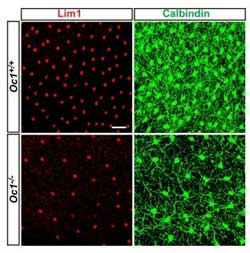Gene regulator is key to healthy retinal development and good vision in adulthood

Confocal microscope images show far fewer horizontal cells generated in mice without Onecut1 (bottom panels) compared to those in normal mice (top panels). <br>
Scientists are developing a clearer picture of how visual systems develop in mammals. The findings offer important clues to the origin of retinal disorders later in life.
In research published this week in the Journal of Neuroscience, University at Buffalo scientists and colleagues focused on a particular protein, called a transcription factor, that regulates gene activity necessary for the development of one type of retinal neuron, the horizontal cells.
Horizontal cells process visual information by integrating and regulating input from rod and cone photoreceptors, which allow eyes to adjust to see well in both bright and dim light conditions.
“We have found that activation of the transcription factor named Onecut1 is essential for the formation of horizontal cells,” explains Xiuqian Mu, PhD, assistant professor in the departments of Ophthalmology and Biochemistry in the UB School of Medicine and Biomedical Sciences.
The researchers came to this conclusion after creating mice that lacked Onecut1. In these knockout mice, the number of horizontal cells was 80 percent lower than in normal mice.
The researchers were surprised to find that the removal of Onecut1 also had an impact on photoreceptor cells, the rods and cones that absorb light in the retina and convert that energy to an electrical impulse eventually conveyed to the brain.
During development, Mu explains, the removal of Onecut1 only appeared to impact the horizontal cells. However, by the time these mice reached adulthood, around 8 months old, the level of photoreceptor cells in these knockout mice was less than half the normal level.
“Because degradation of photoreceptors is believed to be a major factor in retinal diseases, such as retinitis pigmentosa and Leber’s congenital amaurosis, this finding, that horizontal cells are necessary for the normal survival of photoreceptor cells, is novel and significant,” says Mu. “Many retinal diseases are manifested by the degeneration of photoreceptor cells.”
This finding was unexpected, Mu explains, because most investigations into the degeneration of photoreceptor cells have involved genes that directly affect photoreceptor cell development.
“People haven’t been looking at horizontal cells,” he says. “We didn’t think that they’d be involved in photoreceptor cell degradation.
“With this finding, we have discovered that retinal horizontal cells are required for maintaining the integrity of the retina and that their deficiency can lead to retinal degradation,” explains Mu.
He notes that in most cases where photoreceptor cells die, it’s because they are somehow defective.
“But in this case, the photoreceptor cells are fine in the beginning, so the death of the photoreceptor cells is a secondary affair that is somehow driven by the deficiency in horizontal cells,” he says.
UB co-author Steven J. Fliesler, PhD, Meyer H. Riwchun Endowed Chair Professor, vice-chair and director of research in the Department of Ophthalmology and professor in the Department of Biochemistry, notes that this finding could open up a new area of study.
“One scenario we have speculated upon is that there are important supportive interactions between horizontal cells and photoreceptors that are required to maintain photoreceptor function and viability,” Fliesler says. “When horizontal cells are blocked from being formed — the immediate consequence of knocking out Onecut1 — the photoreceptors don't get what they need to survive, so they degenerate and die later on.”
The majority of the research was conducted in the UB Department of Ophthalmology/Ross Eye Institute and the developmental genomics group at UB’s New York State Center of Excellence in Bioinformatics and Life Sciences.
First author on the paper is Fuguo Wu of UB. Other UB co-authors are Renzhong Li, Tadeusz J. Kaczynski, Darshan Sapkota. Additional co-authors are Yumiko Umino and Eduardo Solessio of SUNY Upstate Medical University, Shengguo Li and Mengqing Xiang of the University of Medicine and Dentistry of New Jersey, David M. Sherry of the University of Oklahoma Health Sciences Center and Maureen Gannon of Vanderbilt University Medical Center.
Mu, Fliesler and Solessio also are faculty members of the SUNY Eye Institute, a SUNY-wide eye research consortium.
The work was supported by the Whitehall Foundation, the National Eye Institute, the SUNY/RF Research Collaboration Fund, Research to Prevent Blindness, the Oklahoma Center for the Advancement of Science and Technology, the Lions of Central New York, and resources and facilities provided by the Veterans Administration Western NY Healthcare System.
Media Contact Information
Ellen Goldbaum
Senior Editor, Medicine
Tel: 716-645-4605
goldbaum@buffalo.edu
Twitter: @egoldbaum
Media Contact
More Information:
http://www.buffalo.eduAll latest news from the category: Life Sciences and Chemistry
Articles and reports from the Life Sciences and chemistry area deal with applied and basic research into modern biology, chemistry and human medicine.
Valuable information can be found on a range of life sciences fields including bacteriology, biochemistry, bionics, bioinformatics, biophysics, biotechnology, genetics, geobotany, human biology, marine biology, microbiology, molecular biology, cellular biology, zoology, bioinorganic chemistry, microchemistry and environmental chemistry.
Newest articles

Microscopic basis of a new form of quantum magnetism
Not all magnets are the same. When we think of magnetism, we often think of magnets that stick to a refrigerator’s door. For these types of magnets, the electronic interactions…

An epigenome editing toolkit to dissect the mechanisms of gene regulation
A study from the Hackett group at EMBL Rome led to the development of a powerful epigenetic editing technology, which unlocks the ability to precisely program chromatin modifications. Understanding how…

NASA selects UF mission to better track the Earth’s water and ice
NASA has selected a team of University of Florida aerospace engineers to pursue a groundbreaking $12 million mission aimed at improving the way we track changes in Earth’s structures, such…





















